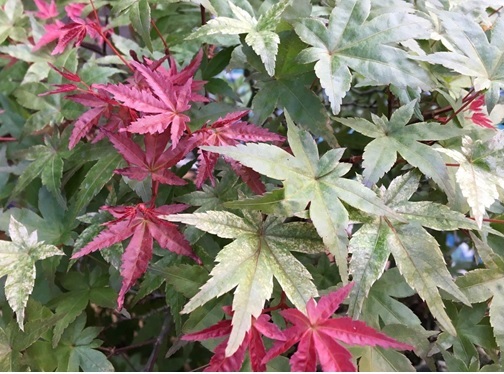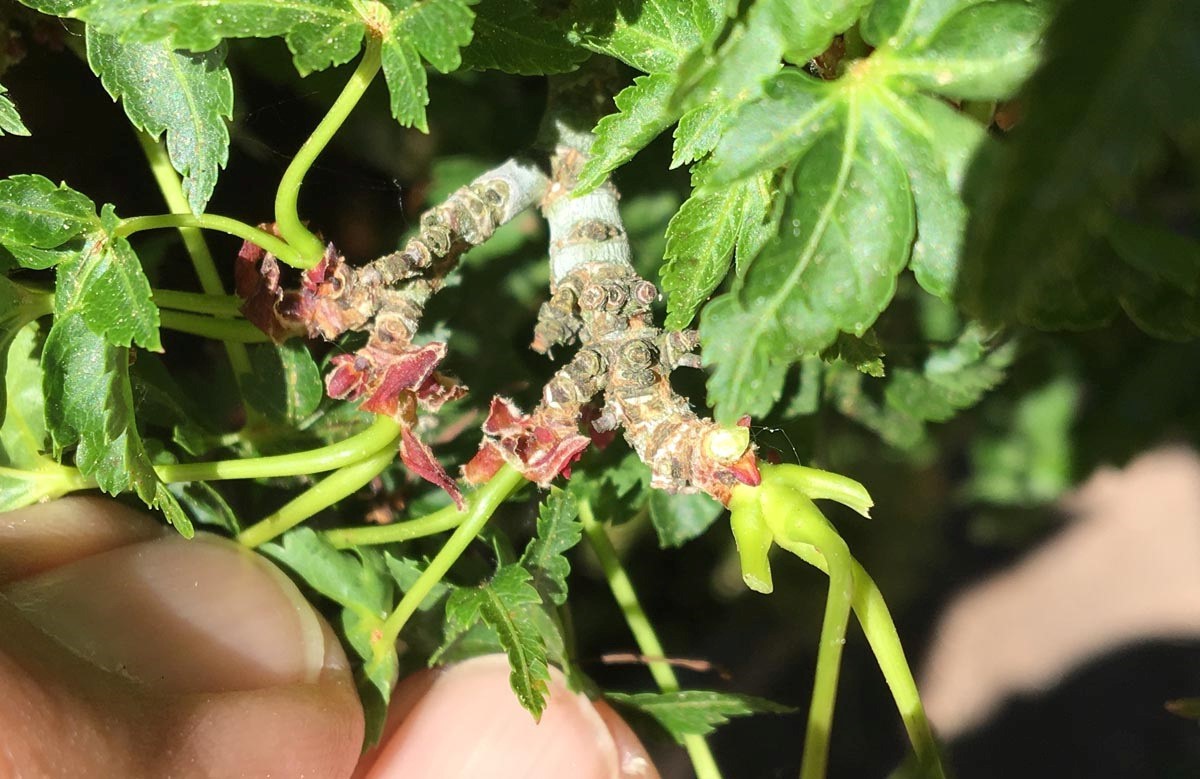Now that we are passing through the middle of June, our work is starting to shift. Pinching is a thing of the past and we are in the middle of Post-Flush, Hardened Pruning. What a mouthful, but accurate way to describe where we are. We touched on this last month quite a bit, especially with deciduous trees. However, by the time you read this, you should already have decandled any multi-flush pines, and started pruning other pines and elongating species. More on that in a moment.
What PFHP (my new acronym) is taking advantage of is the fact that plants have made their initial, and sometimes only, flush of growth for the season. As all or part of this growth hardens off (becomes darker, more rigid) it starts to contribute resources back into the plant. It is still in a foliar growth mode, rather than the vascular mode that it shifts to in the fall. What we are doing with pruning at this time of year is to stimulate the tree to put out another flush of growth that can harden off before next fall.
All pruning at this time of year will slow the tree down. Just keep that in mind with your goals. Most deciduous trees will respond well and give us another push of growth with shorter internodes, smaller leaves, and thinner twigging. Some will even do it a third time. A few, not at all. Most conifers will not flush again, but we can use pruning at this time of year to balance strength and set our buds exactly where we want them for next year.
If you look at all of these techniques in a broad sense
, they are ALL really a form of partial defoliation, even the conifers. In all forms, we are just removing parts of the existing foliage, with variations that come in the amount and timing. I have pruned many of my trees in past years during the months of July and August and not had that great of a response. What I did not realize is that some of these trees had already shifted into vascular growth, so their foliar response was minimal. I also had not fertilized to build adequate resources for the tree to push again. A great example is Doug Fir, where we know that we have a thin margin of about two weeks in late June/July that we can prune to existing, but rather minute buds, and have them activate and set up for next year.
Otherwise those back buds just sit there and do nothing, ever. We ride the fine line transition from foliar to vascular growth to force the desired result. Luckily, most trees are not so finicky. We do have a time now that we can prune back to any existing bud on almost any tree and be safe. I will be pruning my spruces next week, just as soon as this brace gets off my wrist (Carpal tunnel surgery last week, thank goodness. A long time coming. It makes typing this a real bother, though). And my Doug Firs and true firs also.
Junipers will wait until the heat of the summer when I will also work on restyling them. I am just about finished pruning with my deciduous trees, and am experimenting, and hopefully keeping record of partial defoliation on species I have never tried, nor anyone else that I know of. A bit of a gamble, but I think most will pay off. Crabapples, Hawthorns, Persimmon, Wisteria, and Katsura, to name a few.
As you go about pruning, remember that if you prune your fruit and flowering trees past July, you may get new growth, but you are likely pruning off the flower buds for next year, or cause the tree to abort flower bud production and concentrate on foliar production. If you are in development, there’s no problem. Just no flowers next year. Also, try to keep more foliage on any tree as we head into the heat. Think of the foliage as a big radiator. The more foliage, the more heat the tree can remove from its system and stay cooler. That’s almost counter intuitive for me.
Now back to multi-flush pines (Essentially just Japanese Black and Red Pines) that are in a refinement stage. Remember, it doesn’t do much good to decandle a tree unless it is styled and you have a plan for refinement. Otherwise, you are just pruning blindly and may actually inhibit the development of your tree. The same could be said for most pruning. Make sure you have a clear plan. That plan can change based on what the tree gives you, but you must start somewhere.
On June 1st, right on schedule, I went to work on several of my red pines that I have raised from seed and wired and styled for the first time last fall. Now, I thought, I am finally ready for refinement. But as soon as I got my scissors in hand began to inspect a little closer, I noticed that I didn’t have any back buds, or almost none, on any branches. We are talking Shohin and Chuhin sized trees with no buds for 3-4 inches. And therein lies the great deception.
Most of us have always thought that decandling a multi-flush pine will generate back buds. But I have to say that after twenty years of continuous decandling efforts, I am not sure that I have ever seen that happen. Here is where discipline kicks in. I need to let all of the shoots on those still-in-development red pines extend so that I substantially increase the foliage mass – I pruned a lot off when setting the branch structure for the first time. Now that they are pushing strongly, with a much larger foliage mass, they will begin to create greater vascular tissue, building highways for nutrient transport, which will then stimulate the precious back buds that I seek.
Then I can begin the cut back and decandling process, sigh, next year. All of this you may know, but it really struck me that after all my efforts over the years to accumulate technique, that I really needed to apply myself, as well as my newest gained knowledge, and let patience have its perfect work. I know that by maintaining my water balance and a steady stream of fertilizer and sunlight that I will be rewarded with copious back budding in the fall. This I have seen at times, but not realized exactly why, and now all the pieces are starting to fall into place. It’s highly gratifying to know that I recognized a situation and applied the correct knowledge and used restraint, rather than the blade.
Scott Elser





















